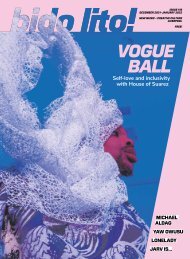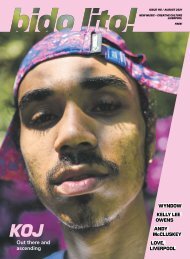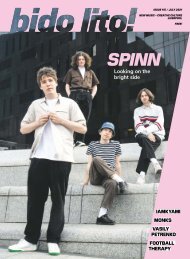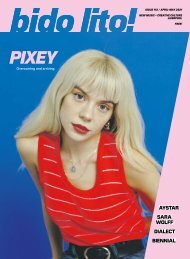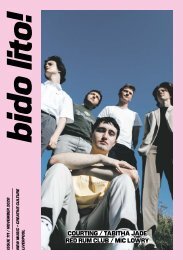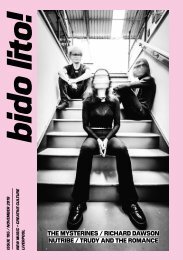Issue 90 / July 2018
July 2018 issue of Bido Lito! magazine. Featuring: MC NELSON, THE DSM IV, GRIME OF THE EARTH, EMEL MATHLOUTHI, REMY JUDE, LIVERPOOL BIENNIAL, CAR SEAT HEADREST, THE MYSTERINES, TATE @ 30 and much more.
July 2018 issue of Bido Lito! magazine. Featuring: MC NELSON, THE DSM IV, GRIME OF THE EARTH, EMEL MATHLOUTHI, REMY JUDE, LIVERPOOL BIENNIAL, CAR SEAT HEADREST, THE MYSTERINES, TATE @ 30 and much more.
Create successful ePaper yourself
Turn your PDF publications into a flip-book with our unique Google optimized e-Paper software.
Asian Dub Foundation: La Haine live Soundtrack<br />
Bam!Bam!Bam! @ Invisible Wind Factory – 25/05<br />
Here are the young men with weights on their shoulders. How a film crams 20 terror-filled hours<br />
into a more easily digestible 98 minutes; how a film depicts the urban terror of young lives blighted<br />
by police brutality and the mistrust of immigrants. And so it goes…<br />
Now rightly seen as a masterpiece of its genre, Matthieu Kassovitz’s film La Haine (Hatred) is a<br />
complex, monochrome feast which details the lives of three friends (Saïd, an Arab, Hubert, an African<br />
and Vinz, a Jewish skinhead) over the course of one day following a riot in the banlieue, a huge,<br />
sprawling estate where they all live. The film is steeped in endemic racism from end to end.<br />
Their friend Abdel has been beaten by the police and lies in a coma in hospital. The estate is in<br />
tatters and the CRS (riot police) are patrolling the area for miscreants. During the course of the film<br />
the three attempt to go about their day-to-day business as best as they can, thwarted at every twist<br />
and turn by the forces of oppression.<br />
What it shows best is the utter mundanity of life for young men with very few options in their<br />
life. Their shallow lives consist of very little other than rolling joints and avoiding the police and their<br />
harsh method of dealing with the local youth. From Paris to Port Said, in all the world’s conurbations,<br />
for young men divested of a future and with no real footing in the present, the song remains the<br />
same. This could be anywhere where young people congregate and call their home. I grew up on a<br />
council estate that, while predominantly white, offered young men the exact same option: absolutely<br />
fuck all. These young men have nothing but each other.<br />
The day gets worse at every available opportunity and, although the narrative constantly talks<br />
of better times and a misplaced idea of what the future will be, a dark, dystopian pall hangs over<br />
everything. These young ‘uns have nothing, not even an immediate future and the desperation of it all –<br />
twinned with a gallows humour that things will get better – underpins almost every moment of dialogue.<br />
The tension and the danger are expressed via Pierre Aim’s supreme cinematography. Utilising<br />
that most French of techniques, cinema vérité, the camera never stops moving. Whether it be<br />
Hubert’s smouldering gym, torched in the riot, or the very real anger that occupies Vinz’ furious<br />
face, it’s all captured in a dark, grainy, ever flowing monochrome. No colour, just dark and shade<br />
illuminating the screen, it appears to accentuate everything and gives it a realness that Technicolor<br />
may have overlooked. This is the element that has separated it from all other films of its genre in<br />
the last two decades. Whereas a lot of its contemporaries were stylised and of the moment, La<br />
Haine has kept that element of unease, an authenticity in both language and image that puts it on a<br />
different plane.<br />
One of its greatest successes on the film’s release in 1995 was its soundtrack, which along with<br />
a smattering of American RnB and Bob Marley, contained a selection of French hip hop that, for most<br />
people in the English speaking world, was a revelation. The bombastic nature of the beats and words<br />
only added to the tension in the film. Tonight, at the Invisible Wind Factory, those fine purveyors of<br />
ethno-psychedelia, ASIAN DUB FOUNDATION, are providing their own live soundtrack. The live<br />
soundtrack has become a phenomenon in recent years: all manner of films from Star Wars to Tron<br />
to DW Griffiths’ Birth Of A Nation have been given the treatment with varying degrees of success.<br />
Some are played by a <strong>90</strong>-piece orchestra, some by your local dead cool band, hoping to create a<br />
new environment. Here, where the soundtrack is absolutely essential to the overall experience of<br />
the film, the ante is raised considerably. ADF rise to the occasion. The opening sequence works<br />
incredibly well, the new soundtrack adding to the tension and unease and complementing the action<br />
in gritty detail. It gives certain parts of the film a whole new dimension and offers a new view of the<br />
experience. I find myself, right from the off, becoming totally engrossed in the imagery above the<br />
band. At times – and I’m not sure whether this is a good or a bad thing – the band seem to disappear<br />
completely and hold back imposing their trip on the images. It’s a fantastic experience, marred only<br />
by a few moments when the live track imposes its trip on the movie and creates a sound clash where<br />
the dialogue becomes muddied.<br />
On the whole, though, I like it a lot. If only for reminding me what a truly wondrous spectacle La<br />
Haine really is; the thrill of watching the film for the first time comes flooding back to me immediately.<br />
It’s one of those niche films that will still be getting talked about in another 20 years’ time, as it<br />
contains a realism that few of its contemporaries have and that will always spark with youth of all<br />
generations and denominations. Giving already established, popular films new soundtracks will grow<br />
and grow, to varying degrees of success. But in the right hands, the right film can be re-introduced<br />
to you by your friendly neighbourhood leftfield pop band and make an enormous splash. It’s only a<br />
matter of time before the ‘game-changer’ in the genre comes along.<br />
Bernard Connor / @bernieworld<br />
ROUND UP<br />
A selection of the best of the rest from another<br />
busy month of live action on Merseyside.<br />
Blossoms (Jamie Sherwood)<br />
At Invisible Wind Factory, Jennifer Rose is on hand to see Stockport-based indie rock<br />
behemoths BLOSSOMS storm on stage like veterans, despite only being five years and<br />
two albums into their career. Frontman Tom Ogden cajoles the crowd throughout, from the<br />
five-piece’s opening number There’s A Reason Why (I Never Returned Your Calls) – the<br />
opening track from their second album, Cool Like You – right through to the night’s sweaty<br />
denouement.<br />
Blossoms’ newest songs, such as Unfaithful and Between The Eyes, stand up well<br />
alongside their more well known material, and show why their latest synth pop-inflected<br />
album should be on everyone’s summer playlist. The rendition of Love Talk is one of many<br />
microphone-in-crowd moments, and there are points of intimacy scattered throughout the<br />
high-octane moments, in particular when Ogden takes centre stage on his own for the<br />
acoustic My Favourite Room.<br />
There’s minimal chat from Ogden throughout, preferring to let the positive vibes flow on<br />
a night that he later assures us is “one of the best”. This is even despite a few rowdy sorts<br />
trying to spoil the atmosphere. It’s difficult to be disappointed at a Blossoms show, however,<br />
as it’s always a showcase of infectious energy when they’re on form. And they’re on form<br />
tonight.<br />
Max Baker recalls some post-midnight revelations from another successful BALTIC<br />
WEEKENDER, as revellers bask in the sun and clamour to see some of the biggest names in<br />
house and techno. The Baltic Triangle has become a pocket of activity for the clubbing scene<br />
in recent years, and the popularity shows in the length of the queues outside main venues<br />
Constellations and 24 Kitchen Street.<br />
As Saturday night turns into Sunday morning, the Constellations crowd ends up in the<br />
loved-up embrace of KRYSTAL KLEAR. As someone with a soft spot for any hint of retro<br />
synth action, this was always going to be the highlight of the weekend, even with all the<br />
heavy hitters on show. Klear’s nod to late 80s house comes across well in the club’s interior,<br />
keeping energy levels high – even for those who’ve been going since mid-afternoon. Everyone<br />
from the Discogs trawlers to the end-of-exam merrymakers keep their engines going and<br />
show a collective appreciation late into the night. A true godfather of house and one half of<br />
Masters At Work, KENNY DOPE justifies his status at the top of the bill with a track selection<br />
that remains true to his <strong>90</strong>s New York roots, while delivering a crisp, contemporary feel.<br />
This is only Baltic Weekender’s second year, but through a combination of great bookings<br />
in great locations, the festival is already establishing itself as a flagship event in the North<br />
West’s bustling dance scene.<br />
Full reviews of all these shows can be found now at bidolito.co.uk.<br />
La Haine<br />
Baltic Weekender (Daniel de la Bastide / @dannydelabastide)<br />
REVIEWS 41




